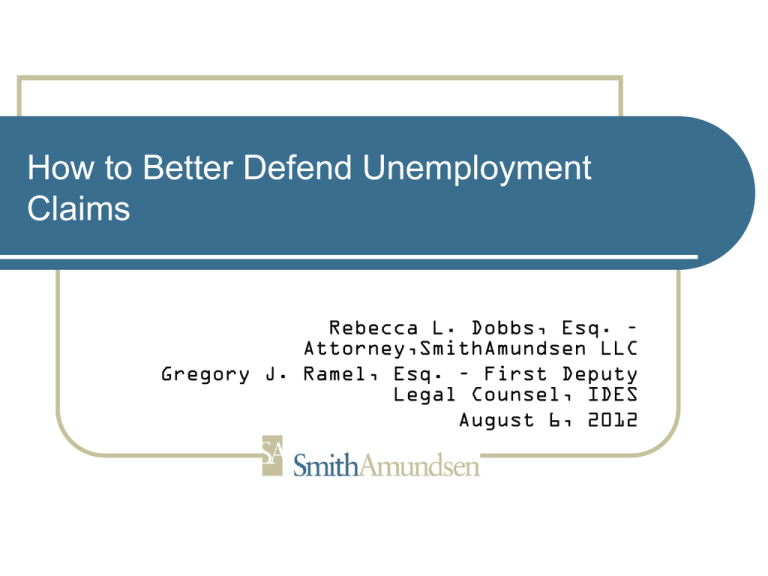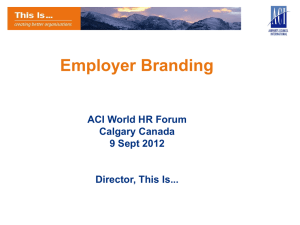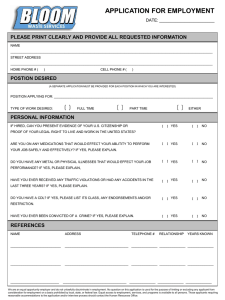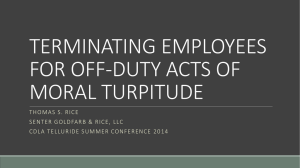2012 Conference Preso
advertisement

How to Better Defend Unemployment Claims Rebecca L. Dobbs, Esq. – Attorney,SmithAmundsen LLC Gregory J. Ramel, Esq. – First Deputy Legal Counsel, IDES August 6, 2012 Unemployment Jurisdiction IDES has jurisdiction to determine and assess employer contribution rates and to enforce its determinations and assessments through its internal review and hearing process IDES also has jurisdiction over benefit payments and disbursement – complete authority over determining benefit entitlements, subject only to judicial review by the appropriate circuit court following the exhaustion of all administrative remedies Employer Interests in Enforcing UI Laws Employer contribution rates based in most part upon company’s experience rating, benefit charges and wages paid. Employer’s financial interest to challenge claimants when appropriate to disqualify a former employee from benefits Preventing unwarranted claims keeps an employer’s benefit charges and rates low which helps keep the lowest contribution rate possible, and the lowest quarterly payments as possible. Employer Funding Unemployment insurance compensation fund is largely made up of a payroll tax paid by employers on a quarterly basis No payroll deductions are made from a worker’s wages to subsidize the unemployment insurance compensation fund Amount an employer pays depends on: Size of employer’s workforce & number of former workers receiving unemployment benefits Employer’s experience rating Employer Funding (cont.) Rates Maximum Minimum Taxable Wage Base 2011 8.40% 0.70% $12,740 2010 7.25% 0.65% $12,520 2009 6.80% 0.60% $12,300 Thanks to IL Chamber and others… (SB 72/PA 97-621): Section 235 (820 ILCS 405/235): Sets the taxable wage base as follows: Calendar Year Taxable Wage Base 2012 $13,560 2013 $12,900 2014-2019 $12,960 Section 1506.1 (820 ILCS 405/1506.1): Sets an employer’s minimum rate at zero for calendar years 2012-2019. Max rates begin in 2012 at 9.45% (including fund building rate). Section 1506.3(820 ILCS 405/1506.3): Sets the fund building rate at 0.55% for each calendar year when on October 31st of the prior calendar year, there are outstanding bonds under the UI Trust Fund Finance Act. Stages to Monitor Unemployment Rate/Claims Initial Claims by individual employees Quarterly Charge Benefit Statements Annual Rate Notice Quarterly Benefit Charge Statement Annual Rate Notice Employee Eligibility Sufficient Base Period Wages in Covered Employment Registration and Availability for Work Reasonable and Diligent Search for Work Periodic Certification of Benefits Claimed Disqualification of Otherwise Eligible Employee Complete or Partial Disqualification Partial Disqualification Arises primarily from income earned by a claimant during receipt of benefits If a claimant earns more than 50% of his “weekly benefit amount,” the amount of benefits he or she is eligible for decreases correspondingly Complete Disqualification If a claimant earns the same or more from other “employment,” then he or she is disqualified from receiving benefits for that week. Discharge for Misconduct Termination for misconduct renders an employee ineligible for benefits until he or she is re-employed earning at least the same weekly benefit amount in each of at least 4 weeks Misconduct – deliberate and willful violation of a reasonable work rule or policy of the employing unit, governing the individual’s behavior in the performance of his work, provided such violation has harmed the employing unit or other employees or has been repeated by the individual despite a warning or other explicit instruction from the employing unit Determining Factors for “Misconduct” Must be related to the employment having a harmful effect on the employer or other employees Must be deliberate, willful, or with disregard for the employer’s interests Actions which demonstrate an employee’s willful or wanton disregard of an employer’s interests revealed by deliberate violations or disregard of standards of behavior which the employer has the right to expect of its employees or in carelessness or negligence of such degree or recurrence as to manifest equal culpability Attendance as Misconduct Attendance Problems Usually involve violation of abuse of employer’s attendance policies Example 1: Man receives a call at work from his wife telling him she is divorcing him. Man immediately clocks out so he can go home to talk to his wife. Supervisor sees him clock out and asks him why he’s leaving. Man refuses to tell his boss anything. The next day he is fired. Misconduct? Yes – but only because he refused to tell his supervisor why he was leaving. Attendance as Misconduct (Cont.) Example 2: Employee gets arrested, locked up and can’t make bail. He can only make collect calls. He sends a letter to his employer explaining his situation and receives no response. He has no family or friends to follow up with his employer. He is locked up for 9 months until his trial at which he is acquitted. He then contacts his employer who tells him he was replaced because he was absent from work without notice for 5 consecutive days. Misconduct? No – The employee tried whatever he could to notify his employer. Insubordination, Harmful Attitude Lack of Professionalism as Misconduct An employee may argue with a superior so long as it is not disparaging or disruptive Critical component is whether there is intentional disregard of an employer’s interests Abusive language is generally considered insubordination and misconduct Words are considered insubordinate and abusive where they violated the behavior standards an employer has a right to expect from its employees Dishonesty, Theft or Felony Conviction as Misconduct Benefits prohibited where an employee is terminated because of the commission of a felony or theft committed in connection with work. Disqualification for termination due to a felony or theft Employer must have no involvement or responsibility Employer must have notified the IDES of the possibility of a felony or theft within 10 days following the employee’s next claim for benefits Employee must either: 1) admit to the felony to a representative of the IDES Director 2) Sign a written admission of the felony or theft to be delivered to the IDES; or 3) Be convicted of, or given an order of supervision by a court, the felony act or theft Job Performance Problems as Misconduct Generally: Incompetence = unemployment If job performance fails to improve after work performance assistance or training, may change to a situation of misconduct The greater the potential risk to the employer as the result of poor performance, the more likely an ultimate termination may be found to be misconduct. And, the employee must be well aware of the potential harm to be caused the employer if poor performance continues. Voluntary Termination or Resignation Voluntary Termination will disqualify a former employee from benefit eligibility. However… exceptions to this rule… Voluntary Termination - Exceptions When worker is deemed physically unable to perform work by a licensed and practicing physician When worker left work for that of another employer and works for at least 2 weeks for the new employer Where a worker refuses to accept a transfer to other work offered by his employer under terms of a CBA or employer plan when such work would result in the separation of another worker currently performing this work Where sole reason for leaving work was sexual harassment of the worker Where work accepted after worker’s separation would be deemed unsuitable for him Where the worker leaves because he/she is a victim of domestic violence Expansion of this exception continues to develop… Factors to Determine “Voluntary” Employee has chosen to leave the employment for reason not attributable to the employer “Attributable to the employer” does not require “fault” It requires more of an “absence of fault” on the part of the employee Factors to Determine “Voluntary” (Cont.) Example 1: Employer is reorganizing – results in changes to the duties and responsibilities of a particular manager. Manager resigns. Resignation attributable to employer? Yes – changes will most likely be considered substantial changes to the “working agreement” understood and expected by the employee Must be a substantial and unilateral modification to the employee’s working conditions, duties, responsibilities of reasonable expectations associated with the job position. Factors to Determine “Voluntary” (Cont.) Example 2: Employee takes 2 week leave of absence and asks for extension which is denied. Does her failure to return to work at end of 2 weeks result in voluntary termination? Yes – Employer is within its rights to deny an extended leave of absence. Employee’s decision to not return to work was a voluntary decision Voluntary Resignation or Constructive Discharge? Constructive Discharge = “forced to quit” Employee’s working conditions are so intolerable that the employee is forced to resign voluntarily Test: what a reasonable person would do under the circumstances i.e, Were the newly (intentionally) imposed conditions so difficult or unpleasant that a reasonable person in the employee’s shoes would have felt compelled to resign? Acceleration of Voluntary Termination Date Example: Employee provides 2-week notice of her resignation. Employer tells her to clean out her desk by the end of the day. Is she terminated? Yes – employee was willing to work 2 more weeks Constructive Quit Results from employee’s action that results in his or her inability or unwillingness to continue working, and for a reason not attributable to the employer Emphasis is often given to the intent of the employee Refusal of Suitable Work Where an individual refuses suitable work, they become ineligible for benefits Refusal of work arises only after a discharge or separation “Suitable Work” Means suitable to a person’s job skills or training, along with comparable pay. Cannot be refused simply because it is not within employee’s “preference.” An offer of work must be definite and genuine, and the terms or conditions for accepting the employment must be reasonable. Acceptable Reasons for Rejecting Suitable Work Significantly lower wages or skills Physical obstacles Safety or potential health hazards; and Other “good cause” Mechanics of an Individual Claim for UI Benefits General Process Initiated by employee as claimant IDES contacts employer Employer may protest claim IDES calculates benefits, if any Challenging A Claim Protest filed by an employer triggers employer’s right to receive an Adjudicator’s Determination as to the claimant’s eligibility for benefits Where protest is timely filed and includes all necessary information, an employer is entitled to party status in further claim proceedings and has all appeal rights arising from such proceedings and resulting determinations. IDES can challenge claim Typically arises from finding of ineligibility during calculation of benefits phase Appeal of Decision or Determination General Process Claims Adjudicator To Referee To IDES Board of Review To Circuit Court Most Common Litigation Issues Not amount of benefits to which a claimant is entitled but whether termination disqualifies an employee from benefits Ability to make successful protests requires a strong familiarity with all the different grounds for disqualification Evidentiary Rules before IDES Formal rules of evidence to not apply to UI claim hearings and proceedings Matters of witness credibility are typically left to Adjudicator or Referee Even though certain documents or information might be admitted into record, they may be given little or no “weight.” Exhausting Administrative Remedies Illinois Administrative Review Act governs the manner in which a party can seek judicial review Requires an exhaustion of all administrative remedies or administrative appeal rights If a party has not sought relief from all appeal rights allowed by the agency, the party is precluded from seeking judicial review Questions??? SmithAmundsen LLC Labor & Employment Group www.salawus.com







